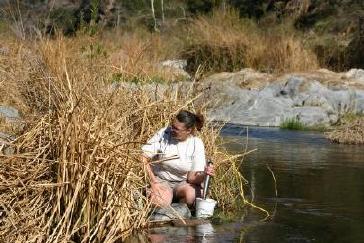
|
|
February 21, 2007 Lessons learned from the SDSU Santa Margarita Ecological Reserve HPWREN Live Interactive Virtual Explorations events during the AAAS 2007 conference exhibit
On February 16th-18th San Diego State University's Santa Margarita Ecological Reserve (SMER) collaborated with the National Science Foundation funded High Performance Wireless Research and Education Network (HPWREN) project to demonstrate the potential for long distance research and education programs for an audience at the AAAS 2007 annual meeting's National Science Foundation booth in San Francisco. During the demonstration, Program Scientist Spring Strahm interacted with National Park Service employee Morgan Robertson and other meeting attendees. The real-time data collection capabilities facilitated by HPWREN were demonstrated by perturbing water sensors at the edge of the Santa Margarita River. Since 2002, SMER and HPWREN have been collaborating with SMER's Research Technology Manager Pablo Bryant supervising the installation of telecommunications towers through the reserve - creating a wireless Internet bubble that covers 90 percent of SMER's 4600 acres. This effort was no small task, given the rugged topography throughout much of the reserve. However the benefits have been immense. SMER is now the most heavily sensored patch of wilderness in the country, with 30 weather stations, 14 web cameras, 13 remote wildfire detecting sensors, and 3 water quality sensors all reporting in real time. In many ways SMER has already demonstrated the potential for projects such as the National Ecological Observatory Network (NEON) and CalEON (California Ecological Observatory Network).
In order to communicate with the conference, Strahm used a laptop running Skype (free Internet phone/video conferencing software), a head set, a video camera, and an additional antenna to add to the laptop's built-in antenna. This set up took approximately 15 minutes to hook together, test and fit inside a backpack to afford better mobility. Pablo Bryant ensured that the network was ready to go ahead of time, and helped Strahm with the setup each day. Once a connection to the conference was made, Strahm provided a brief history of the reserve, and showed off various aspects of SMER's regional and scientific importance. The audience was able to view features she discussed on part of a video wall, and to ask questions via a microphone set up at HPWREN's display. To help facilitate discussions, Morgan Robertson (National Park Service), began asking questions and handing the microphone around to various conference attendees. As part of the presentation, real-time water quality data was being displayed on a screen adjacent to Strahm's video feed. By looking at these graphics, conference attendees were able to look at baseline levels of pH, conductivity and dissolved oxygen in the river. Strahm then demonstrated the capacity of real-time monitoring to record disturbances by placing the sensors in a bucket of water and adding baking soda. This caused rapid changes in pH, dissolved oxygen and conductivity that could be viewed in real-time at the conference. As these changes occurred, Strahm fielded questions from the audience. Lessons Learned (Spring Strahm's Perspective): We began preparing for the conference about four weeks before the actual events. This was largely so we could ensure that we had enough bandwidth to send a clean audio and visual signal to San Francisco, and to make sure that I knew how to use the setup. I came into this presentation style totally green: I had never used Skype before, nor had I ever done or viewed a remote presentation before. Pablo Bryant, our Research Technology Manager, had to walk me through each step, while simultaneously keeping an eye on the wireless network. From the time we began our first practice run with Hans-Werner Braun to the end of the conference, I was learning what it was like to instruct from the other end of a wireless signal. Here is a list of some of those lessons:
A summary of the HPWREN AAAS 2007 exhibit event, as well as a pointer to many more photos, can be found at /news/20070220/.
|


